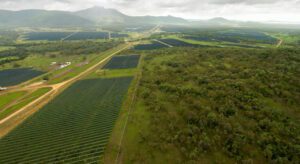A team of European scientists have claimed a new world record for solar energy conversion efficiency with a new ‘tandem’ solar cell design that combines to different technologies to convert almost 30 per cent of sunlight into electricity.
The researchers, based at the Helmholtz-Zentrum Berlin research centre and led by professor Steve Albrecht, published the results of their work in the journal Science, saying that they are now confident that conversion efficiencies using the innovative ‘tandem’ solar cell designs above 30 per cent are now within reach.
“Tandem solar cells that pair silicon with a metal halide perovskite are a promising option for surpassing the single-cell efficiency limit. We report a monolithic perovskite/silicon tandem with a certified power conversion efficiency of 29.15%,” the research paper says.
Achieving a conversion efficiency using the ‘tandem’ solar cell design nearing 30 per cent German research team managed to beat a record recently set by researchers at the Australian National University, who had announced in March they had produced similar mechanically-stacked perovskite-silicon tandem cells with a 27.7 per cent conversion efficiency.
A British research team at Oxford Photovoltaics had also announced ‘tandem’ solar cell designs with a 28 per cent conversion efficiency.
The Germany-based team said that they had achieved the 29.15 per cent conversion efficiency in early 2020, but the research underpinning the feat had only just been published in the journal Science this week.
“29.15% efficiency is not only the record for this technology but is at the very top of the entire Emerging PV category in the NREL chart” PhD student on Albrecht’s research team and a co-author of the study, Eike Köhnen, said.
Tandem solar cells use a combination of two different types of solar cells: conventional solar cells produced using silicon wafers, and next generation perovskite solar cells which are produced using layers of crystallised semiconductor materials.
The two types of solar cell designs absorb light across the solar spectrum at different levels, and by layering the two different techniques on top of one another, researchers have been able to achieve higher solar conversion efficiencies and can overcome the limits of the individual cell designs.
There is a fundamental limit to the amount of sunlight that can be converted into electricity using only a single solar cell layer, dubbed the Shockley–Queisser limit, which has been measured to be 33.7 per cent. However, by combining multiple solar cell types together, as the researchers had done to produce the ‘tandem’ solar cell, solar panels with conversion efficiencies above the Shockley–Queisser limit can be produced.
Perovskite solar cell materials have received significant attention from researchers, as they have the potential to be produced with lower cost materials and through less resource intensive production processes compared to conventional silicon based solar cells. However, the perovskite materials have proven vulnerable to degradation over time, and researchers continue to seek ways of producing longer-lasting next generation cells that would be suitable for commercial applications.
The latest efficiency record was achieved over the course of 300-hour trials – a promising sign that the perovskite materials are achieving greater stability over longer periods, but still substantially short of the operational life for practical uses.
The researchers said that their efficiency milestone had been officially certified by the Fraunhofer Institute for Solar Energy Systems.








